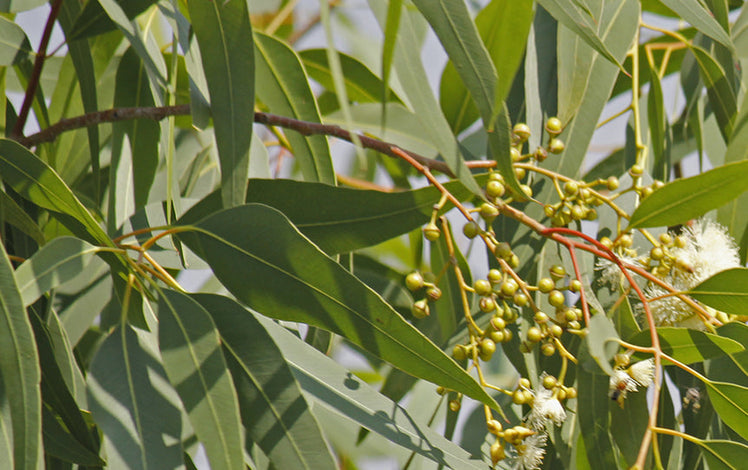A majestic, leafy tree with a distinctly woodsy, refreshing aroma.
Plant name (Latin): Eucalyptus globulus
Plant family: Myrtaceae
Native region: Australia and the South Pacific
Growing habit: A tall tree with blue-green, leathery leaves on white branches
Parts used: Leaves and young twigs
Essential oil extraction method: Steam distillation
About Eucalyptus Oil
Also known as gum trees, eucalyptus have been used for centuries by many cultures. Koalas make their homes in eucalyptus trees, and are one of only two mammals that survive on just eucalyptus leaves. Koalas sleep up to 22 hours a day, but for the rest of us, the clearing, refreshing scent of eucalyptus essential oil is a great way to wake up and breathe deeply.

Why We Use Eucalyptus Oil
Breathe in the distinctly woodsy, sweet aroma of this well loved oil to feel stimulated, refreshed and regenerated.
How and Where Eucalyptus Grows
Eucalyptus trees can vary in appearance, but most are evergreen, and all have copious oil glands that release a fresh, invigorating smell, similar to mint or pine. They have so much natural essential oil that eucalyptus forests can, on warm days, exhale a mist of volatile organic compounds. Australia’s Blue Mountains take their name from this eucalyptus mist. It’s said that soldiers returning to Australia from the two world wars could smell home before they could see it, because of the smell of eucalyptus on the ocean air.
There are over 700 varieties of eucalyptus, which can vary in size from small shrubs to extremely large trees. Most eucalyptus varieties are “gum” trees--if the bark is scratched, a sticky gum will ooze out. One variety of eucalyptus, Eucalyptus regnans, is the tallest flowering plant on earth and second-tallest tree, second only to the Coastal Redwood. While eucalyptus trees may be full of leaves, the leaves have an unusual habit of pointing towards the ground, so they may not offer thick shade.
All eucalyptus trees flower, but their blooms are unique because they don’t have petals. Instead, they have fluffy stamens that vary in colour from white, cream and yellow to pink or even red. Eucalyptus flowers buds are covered with a sturdy cap or lid, known as an operculum, that falls off when they bloom. The name “eucalyptus” comes from the Greek roots eu and calyptos, meaning “well” and “covered”, in reference to the operculum.
Native to Australia and the South Pacific, eucalyptus trees have now been planted in tropical and temperate areas around the world. Generally, eucalyptus trees don’t like the cold, though some varieties can handle more cold than others. Most eucalyptus trees do best in USDA hardiness zones 8 (no colder than -12 degrees Celsius or 10 degrees Fahrenheit) through zones 10 and 11 (no colder than 4 degrees Celsius or 10 degrees Fahrenheit).
Species of eucalyptus are cultivated widely in the tropical and temperate world, including the Americas, Europe, Africa, the Middle East, China, and the the Indian subcontinent. In the United States, eucalyptus plantations can be found in Hawaii and California.
While eucalyptus leaves look green, some of them actually contain gold! Eucalyptus trees need a lot of water, and their root systems go deep. If gold is present in the ground near eucalyptus trees, they will absorb small amounts of it in their search for water, and it winds up in the leaves. While eucalyptus leaves may only have tiny amounts of gold, they can give gold miners valuable clues about where to look for their next valuable strike.
The History of Eucalyptus

The beneficial properties of eucalyptus trees have been well known for centuries. Knowledge of the eucalyptus tree spread to the wider world by the 1600s, when the Portuguese colonized Timor, a small island located north of Australia. While early European explorers must have seen the fragrant tree, the first recorded collection of eucalyptus trees was in 1770, when James Cook’s expedition reached Australia's Botany Bay. By 1790, English doctors documented the used of eucalyptus gum to treat dysentery among convicts in Australia.
Eucalyptus trees played an important part in the development of Australia, and several eucalyptus (gum) trees are important landmarks in Australia, including the Old Gum Tree in Glenelg, where the establishment of the new colony of South Australia’s government was proclaimed in 1836, and the “Tree of Knowledge” in Queensland, where sheep shearers gathered during a strike in 1891.
The Science of Eucalyptus Oil
You might also know the eucalyptus from the Australian folk song “Kookaburra Sits in the Old Gum Tree”. Kookaburras are a type of kingfisher bird with a distinct, laughing call. Contrary to the song, kookaburras are carnivorous and don’t eat eucalyptus leaves or gum. In fact, eucalyptus essential oil contains powerful, natural components that can be toxic in large quantities, so relatively few animals lunch on its leaves. However, koalas have evolved to eat eucalyptus, and some species of possums, birds, bats and insects can eat the leaves as well.
